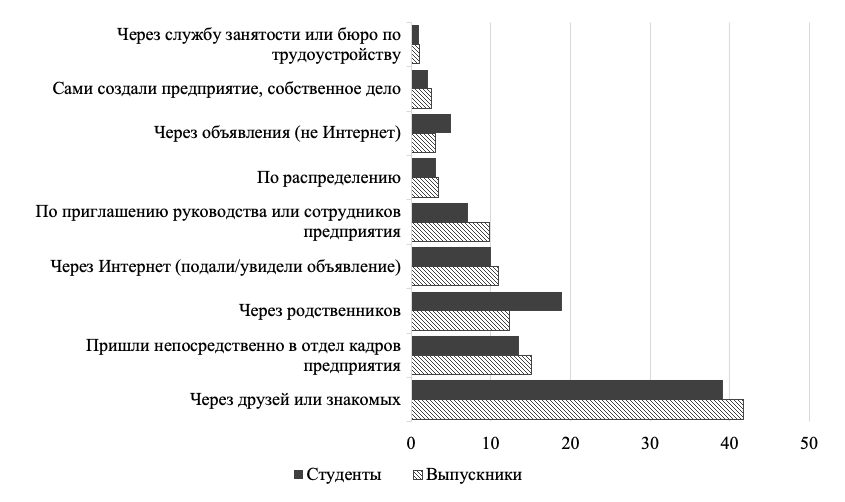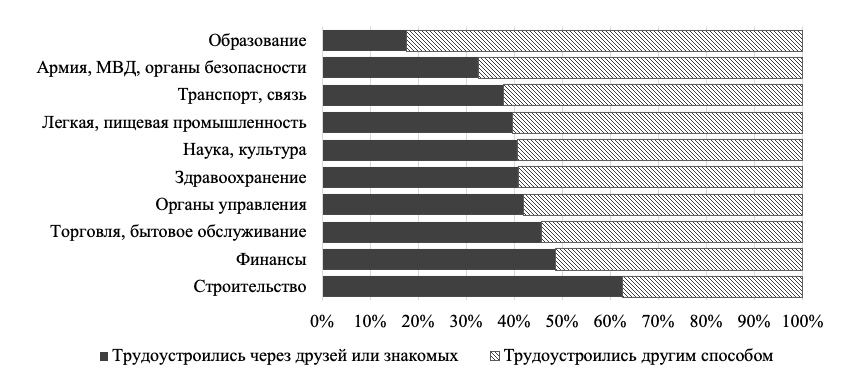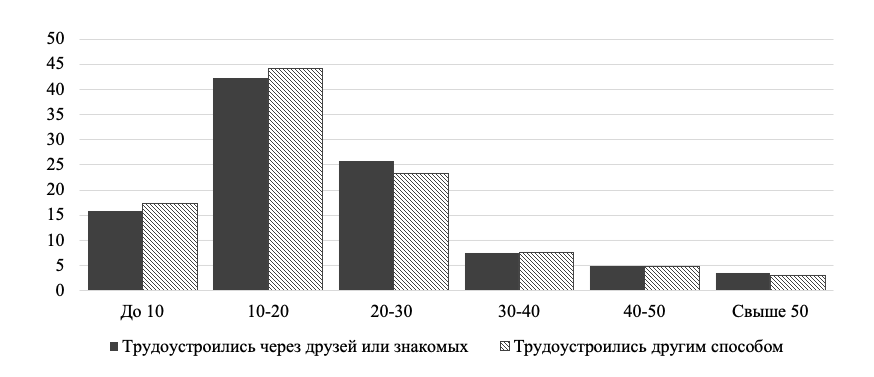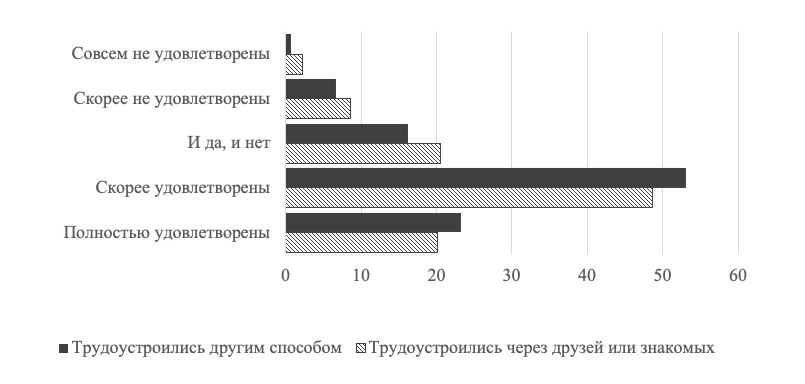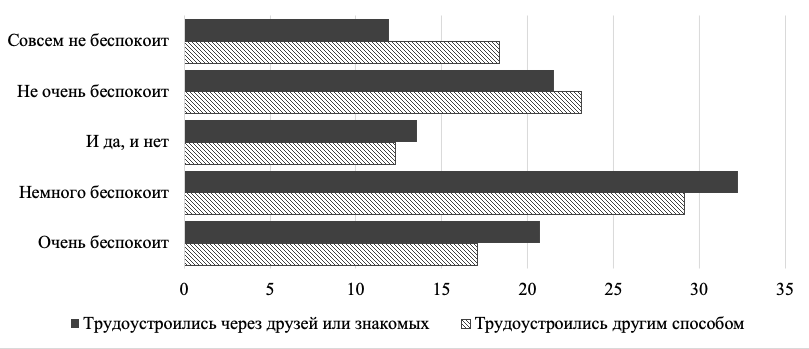- PII
- S013216250010429-4-1
- DOI
- 10.31857/S013216250010429-4
- Publication type
- Article
- Status
- Published
- Authors
- Volume/ Edition
- Volume / Issue 8
- Pages
- 78-89
- Abstract
Social ties seem to play a significant role in the employment practices, including students and graduates, who are most vulnerable categories of employees. This study analyzes significance of informal social ties in the process of job searching for students and graduates. We also investigate the influence of this kind of employment on the objective and subjective criteria of adaptation on the labor market. The study is based on the data of Russian Longitudinal Monitoring Survey (RLMS-HSE). A statistically significant impact of employment by using friends on the subjective indicators (such as job satisfaction) was found. On the other hand, there are no connections between employment by using friends and objective indicators of adaptation on the labor market.
- Keywords
- students, graduates, social ties, employment, job satisfaction
- Date of publication
- 15.09.2020
- Year of publication
- 2020
- Number of purchasers
- 4
- Views
- 228
Занятость молодых специалистов является одной из приоритетных задач социальной политики государства, с одной стороны, и актуальной темой научных исследований – с другой. Ведь молодежь – это работники, обладающие современными компетенциями, высоким уровнем человеческого капитала и трудовой мобильности. В то же время молодежь в рамках трудовых отношений характеризуется недостаточным трудовым опытом, социальной незрелостью и изменчивым трудовым поведением [Колесникова и др., 2013].
В отечественных эмпирических исследованиях, посвященных вопросам молодежной занятости, отмечается, что существуют определенные сложности в адаптации молодых специалистов на рынке труда, связанные с продолжительным временем поиска работы, более низкой оплатой труда и т.д. [Нарчуганов и др., 2014; Миниахметова, 2010; Ангаева, 2009]. В этой связи выглядит рациональным использование молодыми специалистами неформальных социальных связей – обращение за помощью при трудоустройстве к друзьям и знакомым.
Социальные связи индивида представляют собой одну из форм социального капитала [Bourdieu, 2001; Радаев, 2002]. В многочисленных исследованиях подчеркивается, что набор социальных связей (социальная сеть индивида) – это базис, на который накладываются другие формы социального капитала [Полищук, Меняшев, 2011; Lin, 2001; Burt, 2001; Van Deth, 2008]. В силу сложности природы социального капитала его трудно измерить как на уровне отдельного индивида, так и на уровне группы или общества в целом. Однако в рамках сетевого подхода существуют релевантные методы, позволяющие получать не только количественные оценки социального капитала, но и анализировать его структуру и динамику изменения [Woolcock, Narayan, 2000].
Социальный капитал наряду с другими формами капитала приносит своему владельцу факторный доход – выгоды от обладания данным ресурсом. На рынке труда эти выгоды связаны со снижением асимметрии информации и транзакционных издержек (см. [Cahuc, Fontaine, 2002; Calvo-Armengol, Zenou, 2005; Castiglione, Van Deth, Wolleb, 2008] и др.). Использование данного вида социального капитала при поиске работы сокращает время поиска и расширяет набор доступных вакансий, снижает транзакционные издержки и период безработицы.
Эффективность использования неформальных социальных связей как канала поиска работы подтверждается многочисленными исследованиями в данной области (например, [Smith, 2003; Коньков, 2006; Лаврусевич, 2006; Bentolila, Michelacci, Javier, 2010; Karon, Scott, Laurie, 2015]). Наиболее результативными считаются «слабые связи», то есть обращение за информацией и помощью при трудоустройстве к знакомым или дальним родственникам [Granovetter, 1973]. В частности, обращение к нерегулярным контактам (в том числе к университетским связям) при поиске работы лучше способствует трудоустройству, чем помощь родственников [Neil, Richard, 1994; Grenberg, Fernandez, 2016]. Если информация о вакансиях, известная близкому кругу, доступна и самому соискателю, то «слабые связи» могут предоставить дополнительные сведения о потенциальных вакансиях. Как отмечает А.Т. Коньков, если у человека мало контактов за пределами близкого круга друзей и родственников (у него мало «слабых связей»), то он, скорее всего, обладает ограниченной и неоперативной информацией о рынке труда, что значительно затрудняет поиск работы [Коньков, 2010].
Неоспорима особая важность социальных связей на рынке труда именно для молодых специалистов, ведь данный контингент зачастую не имеет опыта поиска работы и менее конкурентоспособен. Сами выпускники высоко оценивают возможности, предоставляемые социальными связями в процессе поиска работы. Отмечается, что в данной социальной группе превалирует использование «слабых» социальных связей, помощь однокурсников и членов студенческих клубов [Лаврусевич, 2006; Marmaros, Sacerdote, 2002].
В настоящем исследовании анализируется использование неформальных социальных связей как практики трудоустройства студентов и выпускников вузов. Кроме оценки степени распространенности такого типа трудоустройства в анализируемой социальной группе исследуются эффекты, которые оказывает подобное трудоустройство на положение молодых работников в первые годы работы.
Авторами проверяются далее две гипотезы: 1) в процессе трудоустройства молодых специалистов наиболее востребованным является канал поиска работы через неформальные социальные связи, при этом соискатели в большей степени обращаются к «слабым связям» – друзьям и знакомым; 2) процесс адаптации молодых специалистов на рынке труда зависит от способа трудоустройства.
База данных.
Исследование базируется на данных Мониторинга социально-экономического положения и состояния здоровья населения Российской Федерации (RLMS-HSE)1, который проводится ежегодно в виде общенациональных статистических репрезентативных опросов населения. В настоящем исследовании использована база данных за 2012–2016 гг.
Выборка данных о молодежи в возрасте 18–30 лет была отформатирована для анализа положения выпускников и учащихся вузов. В конечную выборку попали только те респонденты, которые на вопрос «Учились ли вы или учитесь в институте, университете, академии?» ответили положительно и указали в качестве основного занятия работу. В результате в конечную выборку, общий объем которой составил 990 наблюдений, вошли 75% респондентов с оконченным высшим образованием и 25% студентов вузов, совмещающих работу и учебу.
В группе выпускников (22–25 лет) доля женщин на 10% больше, в группе студентов (18–21 год) женщин больше в 2 раза, в старшей группе (26–30 лет) женщин в 2 раза меньше, чем мужчин. Более 50% респондентов (студенты и выпускники) работают в четырех отраслях – торговля и бытовое обслуживание (33 и 22%), образование (10 и 9%), транспорт и связь (8 и 11%). Средняя заработная плата выпускников составляет 23,5 тыс. руб.; у студентов – 19,8 тыс. руб. (стандартное отклонение в обеих группах 15,5 тыс. руб.).
Способы трудоустройства выпускников и студентов.
Распределение ответов респондентов на вопрос «Как вы нашли вашу основную работу» показывает (рис. 1), что использование неформальных социальных связей (помощи друзей, знакомых или родственников) является самым частым, причем с большим отрывом (его использовали около 40%), способом трудоустройства выпускников и студентов. Следующие по частоте способы (примерно по 15%) – это трудоустройство через родственников и вариант «пришли непосредственно в отдел кадров». Самым же непопулярным способом трудоустройства среди молодежи является обращение в службы занятости. Таким образом, первая гипотеза полностью подтвердилась.
Рис. 1. Распределение респондентов по способу трудоустройства, %
Рассмотрим, как на распространенность трудоустройства при помощи неформальных социальных связей влияют социально-демографические факторы.
Группировка респондентов по полу, возрасту и способу трудоустройства (табл. 1) показывает, что трудоустройство через друзей или знакомых несколько более характерно для мужчин – так устраиваются на работу около 44%, тогда как для женщин этот показатель – 36%. В обеих гендерных группах показатель поиска работы через друзей в старшем возрасте на 13–14 п.п. выше, чем в молодом возрасте. Это объяснимо тем, что по мере взросления происходит накопление неформальных социальных связей и развитие включенности в социальные сети.
Таблица 1. Распределение выпускников и работающих студентов по полу, возрасту и способу трудоустройства (в %)
|
|
Мужчины |
Женщины |
||
|
Возраст, лет |
трудоустроились через друзей или знакомых |
трудоустроились другим способом |
трудоустроились через друзей или знакомых |
трудоустроились другим способом |
|
18–21 |
36,8 |
63,2 |
29,6 |
70,4 |
|
22–25 |
46,3 |
53,7 |
37,2 |
62,8 |
|
26–30 |
49,5 |
50,5 |
43,4 |
56,6 |
Анализ распределения респондентов по проживанию (табл. 2) показывает, что в среднем трудоустраиваются через друзей или знакомых около 44% респондентов из городов и 38% из сел, т.е. в городах потенциал социальных связей используется несколько чаще, чем в сельской местности. Это можно объяснить более активным ритмом общественной жизни в городе, участием населения в различных социальных сетях (спортивные клубы, клубы по интересам и пр.), в результате чего у молодого горожанина создается достаточно прочная сеть «слабых» социальных связей. Городские социальные сети более эффективны в качестве канала поиска работы, поскольку участники вовлечены не только в оффлайн-, но и в онлайн-сети, отличающиеся высокой скоростью распространения информации. Сельские же жители в меньшей степени используют виртуальные социальные сети в силу уклада жизни и меньших технических возможностей. Кроме того, вузы преимущественно располагаются в городах, а значит поиск работы их выпускниками через социальные контакты, сформированные за время обучения, тоже будет в основном осуществляться в городах.
Таблица 2. Распределение выпускников и работающих студентов по типу населенного пункта, региону и способу трудоустройства
|
|
Город |
Село |
||
|
Возраст, лет |
трудоустроились через друзей или знакомых |
трудоустроились другим способом |
трудоустроились через друзей или знакомых |
трудоустроились другим способом |
|
ЦФО |
44,3 |
55,7 |
47,2 |
52,8 |
|
СЗФО |
41,5 |
58,5 |
64,7 |
35,3 |
|
ЮФО |
47,2 |
52,8 |
37,8 |
62,2 |
|
СКФО |
45,5 |
54,5 |
50,0 |
50,0 |
|
ПФО |
44,3 |
55,7 |
30,8 |
69,2 |
|
УФО |
36,4 |
63,6 |
35,3 |
64,7 |
|
СФО |
42,4 |
57,6 |
21,4 |
78,6 |
|
ДФО |
50,0 |
50,0 |
16,7 |
83,3 |
Изучение взаимосвязи между способом трудоустройства и экономической отраслью (рис. 2) показывает, что в отраслях, в большей степени связанных с государственной службой и бюджетными организациями, дружеские связи для поиска работы используются значительно реже, чем в отраслях, связанных с коммерческой деятельностью. Лидером по частоте трудоустройства через друзей или знакомых является строительство, где таким способ нашли работу более 60% выпускников и работающих студентов. Напротив, меньше всего работников, трудоустроенных через знакомых, в сфере образования (17,6%), а также в армии и органах безопасности (32,5%). Эти закономерности можно объяснить тем, что в бюджетной сфере, где уровень оплаты труда традиционно ниже, чем в коммерческой, трудоустройство через неформальные социальные связи не так актуально в силу меньшего количества претендентов на вакантные должности. Кроме того, формализованный механизм проверки кандидатов (большое количество формальных требований и критериев, которым кандидат на должность обязан соответствовать) во многих случаях просто исключает возможность трудоустройства «по знакомству» в госсекторе.
Рис. 2. Распределение выпускников и работающих студентов по отраслям и способу трудоустройства, %
Трудоустройство с помощью неформальных социальных связей чаще характерно для мужчин, чем для женщин. Это не означает, что у женщин таких связей меньше. Дело в том, что женщины предпочитают работать на контролирующих и распределительных должностях с чуть меньшей зарплатой, но с более предсказуемыми карьерными перспективами и социальными гарантиями. На более высокооплачиваемые и рискованные должности они стараются «устроить» своих мужей, подготавливая себе, таким образом, возможности для деторождения.
Влияние неформального способа трудоустройства на адаптацию молодых специалистов на рынке труда.
Объективными показателями адаптации работника на рынке труда выступают уровень заработной платы и условия труда. В рамках мониторинга респондентам также задавались вопросы об их удовлетворенности работой, степени доверия и уверенности в ней, что позволило дополнить объективные показатели субъективными.
Как видно на рис. 3, заработная плата практически не зависит от способа трудоустройства. Средняя заработная плата трудоустроившихся через неформальные социальные связи составляет 22860 руб. и очень незначительно превышает аналогичный показатель для трудоустроившихся другим способом (21540 руб.).
Рис. 3. Распределение выпускников и работающих студентов по среднемесячной заработной плате (в тыс. руб.) и способу трудоустройства, %
Для комплексного анализа того, какие факторы оказывают влияние на уровень заработной платы молодых специалистов, использовалась регрессионная модель. Были рассмотрены три спецификации этой модели в зависимости от отрасли (промышленность, государственная службы и бюджетные организации, коммерческая деятельность). Результаты эконометрической оценки модели, представленные в табл. 4, подтверждают, что способ трудоустройства не оказывает влияния на заработную плату: для всех спецификаций модели коэффициент перед переменной «способ трудоустройства» является статистически не значимым.
Таблица 4. Оценка факторов, влияющих на заработную плату выпускников и работающих студентов вузов
|
Переменная |
Для всех отраслей |
Для промышленности |
Для гос. службы и бюджетных организаций |
Для коммерческой деятельности |
|
Возраст |
809,3*** (156,1) |
1065,9** (382,9) |
686,6** (234,9) |
789,6** (251,7) |
|
Пол |
7764,8*** (858,4) |
6963,6** (2095,5) |
6807,7*** (1278,9) |
8105,2*** (1484,9) |
|
Способ трудоустройства |
869,6 (861,6) |
-1036,2 (2039,8) |
1400,8 (1292,1) |
198,2 (1482,2) |
|
Рабочие часы |
-139,5 (855,2) |
-4858,9*** (2096,1) |
3665,7** (1220,1) |
-1228,9 (1470,8) |
|
Официальное трудоустройство |
1934,1 (2075,1) |
4398,8 (7272,4) |
-5059,7 (4667,9) |
2661,6 (2972,3) |
|
Уровень мастерства |
1030,6*** (238,7) |
1695,9** (555,6) |
616,6* (351,6) |
1305,1** (413,5) |
|
Тип населенного пункта |
3132,6** (1183,7) |
224,1 (2959,0) |
3652,3* (1621,9) |
3143,3 (2184,7) |
|
Регион |
-1322,6*** (181,5) |
-1680,8*** (464,6) |
1212,8*** (256,2) |
-1404,1*** (315,1) |
|
Число наблюдений |
959 |
154 |
296 |
408 |
Примечание. В скобках указано стандартное отклонение. Уровень значимости: *0,1; **0,05; ***0,01.
Различия в условиях труда в зависимости от способа трудоустройства имеют очень слабо выраженный характер (табл. 5). Уровень заработной платы для обеих групп работников практически одинаковый; средние заработные платы отличаются менее чем на 5%. Выпускники, нашедшие работу по знакомству, чаще работают без официального трудового договора, однако статистически различия не значительны (3,2 п.п.). Проблемы, связанные с неоплачиваемым изменением продолжительности рабочей недели, неоплачиваемым отпуском или какими-либо задолженностями со стороны работодателя, в равной мере характерны для обеих групп работников.
Таблица 5. Взаимосвязь условий труда и способа трудоустройства, %
|
|
Трудоустройство через друзей или знакомых |
Трудоустройство другим способом |
|
Работаете ли вы официально по трудовому договору? |
||
|
Да |
92,8 |
96,0 |
|
Нет |
7,2 |
4,0 |
|
Ваша рабочая неделя составляет 40 часов? |
||
|
Да |
53,6 |
51,0 |
|
Нет |
46,4 |
49,0 |
|
В настоящее время ваше предприятие осталось должно вам какие-то деньги, которые по разным причинам не выплатило вовремя? |
||
|
Да |
3,9 |
4,1 |
|
Нет |
96,1 |
95,9 |
|
В течение последних 12 месяцев вам уменьшали зарплату или сокращали часы работы не по вашему желанию? |
||
|
Да |
5,3 |
3,5 |
|
Нет |
94,7 |
96,5 |
|
В течение последних 12 месяцев вас отправляла администрация в вынужденный неоплачиваемый отпуск? |
||
|
Да |
0,9 |
1,2 |
|
Нет |
99,1 |
98,8 |
|
В течение последних 12 месяцев вы были в оплачиваемом отпуске? |
||
|
Да |
58,5 |
64,1 |
|
Нет |
41,1 |
33,9 |
Таким образом, объективные характеристики занятости практически не зависят от того, как трудоустраивались молодые работники. Далее проанализируем зависимость субъективных оценок адаптации работников на рынке труда от их способа трудоустройства.
Распределение удовлетворенности работой в анализируемых группах (рис. 4) имеет очень близкую структуру. Среди получивших работу через друзей и знакомых 20% полностью удовлетворены работой и 48,5% – скорее удовлетворены. Для другой группы работников данные показатели соответственно равны 23 и 53%. Это значит, что трудоустроенные не через социальные связи в несколько большей степени удовлетворены своей работой, чем трудоустроенные с помощью друзей. Таким образом, в подтверждение второй гипотезы, прослеживается определенная зависимость удовлетворенности работой от способа трудоустройства.
Рис. 4. Удовлетворенность работой и способы трудоустройства, %
Для выявления степени влияния трудоустройства через неформальные социальные связи на удовлетворенность работой был проведен многофакторный регрессионный анализ. В уравнении регрессии зависимой переменной является удовлетворенность работой, она принимает значения от 1 до 5 (где 1 – полностью удовлетворен, 5 – совсем не удовлетворен). Дополнительно были оценены удовлетворенность условиями труда и возможностью профессионального роста (табл. 6).
Таблица 6. Оценка факторов, влияющих на удовлетворенность работой выпускников и работающих студентов вуза
|
Переменные |
Удовлетворенность работой в целом |
Удовлетворенность условиями труда |
Удовлетворенность возможностями профессионального роста |
|
Возраст |
0, 012 (0, 001) |
0,017 (0,011) |
0,009 (0,013) |
|
Пол |
0, 142* (0, 058) |
0,212** (0,062) |
0,065 (0,076) |
|
Рабочие часы |
-0,083 (0,055) |
-0,225*** (0,059) |
-0,102 (0,073) |
|
Официальное трудоустройство |
-0,323* (0,131) |
-0,489*** (0,139) |
-0,842*** (0,171) |
|
Заработная плата |
-0,010*** (0,002) |
-0,112*** (0,002) |
-0,019*** (0,003) |
|
Способ трудоустройства |
0,145* (0,056) |
0,165** (0,060) |
0,231** (0,073) |
|
Регион |
0,027* (0,012) |
0,013 (0,013) |
0,011 (0,057) |
|
Число наблюдений |
988 |
990 |
980 |
Примечание. В скобках указано стандартное отклонение. Уровень значимости: *0,1; **0,05; ***0,01.
Оценка коэффициентов уравнения регрессии позволяет сделать вывод о статистически значимой взаимосвязи способа трудоустройства и удовлетворенностью работой выпускников. Переменная «способ трудоустройства» оказалась значимой во всех моделях и имеет отрицательное обратное влияние. Наибольшее влияние способ трудоустройства оказывает на удовлетворенность возможностями профессионального роста: для трудоустроенных через неформальные социальные связи удовлетворенность снижается на 0,23 пункта при прочих равных условиях.
Важным условием жизни молодого специалиста является уверенность в своей работе. Среди выпускников, трудоустроенных через знакомых и друзей, наблюдается достаточно высокий уровень беспокойства (53%) относительно возможности потерять работу (рис. 5) – в частности, каждый пятый отметил, что очень сильно обеспокоен. В группе работников, получивших работу не через друзей или знакомых, обеспокоенность возможной потерей работы на 7 п.п. ниже (46%). Каждый пятый работник, трудоустроенный не через социальные связи, уверен в своей работе, а для работников, получивших работу через знакомых, аналогичный показатель составляет лишь 12%.
Рис. 5. Беспокойство потерять работу и способ трудоустройства, %
Таким образом, наблюдается определенная взаимосвязь между способом трудоустройства и субъективным отношением выпускников к работе. Выпускники, получившие работу через неформальные социальные связи, чувствуют себя менее удовлетворенными работой, условиями труда и возможностями профессионального роста. Хотя способ трудоустройства оказывает не сильное влияние на показатели удовлетворенности работой, он является статистически значимым. Кроме того, в группе работников, трудоустроенных через друзей и знакомых, беспокойство относительно потери работы выше, чем среди их сверстников, получивших работу другим образом.
Заключение.
Как известно, молодые специалисты при поиске работы решают несколько задач: во-первых, устранение материальных проблем, получение основного или дополнительного заработка; во-вторых, получение профессиональных стажа и опыта, которые не будут лишними как после окончания вуза, так и при дальнейшем устройстве на более перспективную и высокооплачиваемую работу; в-третьих, эприобретение новых знакомств – социальных связей, позволяющих в дальнейшем успешнее подниматься по карьерной лестнице. При этом трудоустройство через друзей и знакомых более характерно для мужчин, чем для женщин. Меньше распространено оно в тех профессиях и организациях, где соискатель должен пройти самую серьезную проверку в обязательном порядке (скажем, в организациях системы МВД).
Трудоустройство через социальные связи в городской и сельской местности также имеет свои особенности. Количество специалистов, необходимых в сельской местности, намного меньше, чем в городской, а информационные технологии распространены не так сильно. Именно поэтому при трудоустройстве в сельской местности в ряде случаев основную роль играет наличие или отсутствие у работника требуемой квалификации (диплома), а порой и само наличие необходимого специалиста (не из кого делать выбор). Искать нужного человека через знакомых просто нет необходимости.
Распространенная практика трудоустройства через социальные связи имеет множество экономических преимуществ – на уровне индивида, компании и экономики в целом. Доходы индивидов растут, связанные с поиском работы транзакционные издержки снижаются, сокращается продолжительность безработицы. Однако субъективная оценка такими работниками своих условия труда имеет более негативный характер. Зачастую, к сотруднику, трудоустроенному «по блату», остальной коллектив относится недоброжелательно. Сам такой сотрудник может ощущать моральную неудовлетворенность от того, что он получил работу по знакомству; такая неудовлетворенность особенно возрастает, когда квалификация работника не соответствует занимаемой должности. В результате социальное давление внутри коллектива и внутренний конфликт приводят к тому, что работники, трудоустроенные посредством социальных связей, испытывают меньший оптимизм в оценке удовлетворенности работой, условиями труда и перспективами карьерного роста.
Важном результатом проведенного исследования является установление, что трудоустройство через неформальные социальные связи не имеет прямой корреляции со случаями дискриминации молодых специалистов, с выявляемыми нарушениями трудового законодательства (в том числе, в сфере оплаты труда). Это говорит о том, что вне зависимости от того, как и каким путем сотрудник попал на предприятие, в отношении его в любом случае начинают действовать общие существующие нормы и правила. Таким образом, обезличенно-рыночные трудовые отношений в нашей стране в основном сложилась и постепенно приобретают должные деперсонифицированные институциональные рамки.
References
- 1. Angayeva A.B. (2009) Analysis of the demand for graduates in the labor market. Vestnik Buryatskogo Gosudarstvennogo universiteta [Bulletin of Buryat State University]. No. 5: 276–280. (In Russ.)
- 2. Bentolila S., Michelacci C., Javier S. (2010) Social Contacts and Occupational Choice. Economica. No. 305 (77): 20–45.
- 3. Bourdieu P. (2001) Forms of Capital. In: Granovetter, M. and R.Swedberg (eds.). The Sociology of Economie Life. 2nd ed. Boulder: Westview Press: 96–111.
- 4. Burt R. (2001) Structural Holes Versus Network Closure as Social Capital. Social capital: theory and research. Еd. by R. Burt. New York: Aldine de Gruyter: 31–56.
- 5. Cahuc P., Fontaine F. (2002) On the Efficiency of Job Search with Social Networks. CEPR Discussion Paper. No. 3511.
- 6. Calvo-Armengol A., Zenou Y. (2005) Job Matching, Social Network and Word-of-Mouth Communication. Journal of Urban Economics. No. 57: 500–522.
- 7. Castiglione D., Van Deth J. W., Wolleb G. (2008) The Handbook of Social Capital. Oxford: Oxford University Press.
- 8. Granovetter M. (1973) The Strength of Weak Ties. American Journal of Sociology. No. 78(6): 1360–1380.
- 9. Grenberg J., Fernandez R. (2016) The Strength of Weak Ties in MBA Job Search: A Within–Person Test. Sociological Science. No. 3: 296–316.
- 10. Karon G., Scott J., Laurie H. (2015) Job loss and social capital: The role of family, friends and wider support networks. SER Working Paper Series. No. 2015-07.
- 11. Kon'kov A.T. (2006) Social capital and economic interaction: monograph. Moscow: RUDN. (In Russ.)
- 12. Kon'kov A.T. (2010). The use of social capital as a strategy of behavior in the American labor market. Zhurnal sotsiologii I sotsial’noy antropologii [Journal of Sociology and Social Antropology]. No. 2(9): 68–87. (In Russ.)
- 13. Kolesnikova Y.S., Kamasheva A.V., Khalikov A.L. (2013) Youth Labor Market and Employment Assistance. Ekonomicheskie nauki [Economic Science]. No. 12 (109): 54–57. (In Russ.)
- 14. Lavrusevich P.Y. (2006) Social networks in employment strategies on the Russian labor market. Ekonomicheslaya Sotsiologiya [Journal of Economic Sociology]. No.2 (7): 74–85. (In Russ.)
- 15. Lin N. (2001) Social capital: a theory of social structure and action. Cambridge: Cambridge University Press.
- 16. Marmaros D., Sacerdote B. (2002) Peer and social networks in job search. European Economic Review. No. 46: 870–879.
- 17. Miniakhmetova L.A. (2010) Professional education and the labor market in Tatarstan and Bashkortostan. Voprosi obrazovaniya [Educational studies]. No. 4: 280–290 (In Russ.)
- 18. Narchuganov A.N., Podborskaya M.V., Svintsova D.A., Datsenko A.V., Azarova S.A., Morkina N.A. (2014) The current state of the labor market in the Krasnoyarsk Territory and the employment prospects of university graduates. In: Assistance to the professional development of the personality and employment of young specialists in modern conditions: a collection of materials of the VI International Correspondence Scientific and Practical Conference dedicated to the 60th anniversary of BSTU. (In Russ.)
- 19. Neil J., Richard S. (1994) The Handbook of Economic Sociology. Princeton University Press: 367–402.
- 20. Polishchuk L., Menyashev R. (2011) Economic value of social capital. Voprosy ekonomiki. [Issues of Economics]. No. 12: 46–65. (In Russ.)
- 21. Radayev V.V. (2002) The concept of capital, the form of capital and their convergence. Ekonomicheskaya sotsiologiya [Journal of Economic Sociology]. No. 4: 20–31. (In Russ.)
- 22. Smith S.S. (2003) Exploring the Efficacy of African-Americans; Job Referral Networks: A Study of the Obligations of Exchange Around Job Information and Influence. Ethnic and Racial Studies. No. 26 (3): 1029–1045.
- 23. Van Deth J.W. (2008) Measuring Social Capital. In: D. Castiglione, J.W. Van Deth, G. Wolleg (eds.). The Handbook of Social Capital. Oxford: Oxford University Press: 150–176.
- 24. Woolcock M., Narayan D. (2000) Social capital: Implications for development theory, research, and policy. The World Bank Research Observer. No. 15: 225–249.
